Broadway
by Clark D. Rodeffer
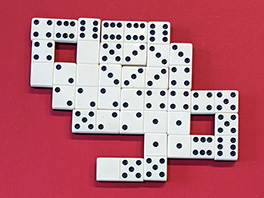
A two-dimensional domino game for four players by Clark D. Rodeffer, in which points are scored for matching adjacent dominoes.
Overview
Broadway is a two-dimensional domino game for four players (two partnerships, with partners sitting opposite) in which points are scored for matching more than one individual tile segment.
Equipment
A double six set of dominos and some means of keeping track of points scored. Simple hash marks on paper works well.
Method of Play
A game is played over a series of seven hands, with each hand’s tableau building upon a double. The first hand starts with the double six, and successive hands continue on down to double blank.
At the beginning of each hand, thoroughly shuffle the tiles face-down. Each player then draws seven tiles. Players may look at and arrange their own tiles as they see fit, but they must not expose their tiles until the turn in which they are played. Likewise, table talk is forbidden.
The player having the double corresponding to the current hand leads it face-up to the center of the table, oriented horizontally from his point of view. Thereafter, each player, in turn, places one tile from his hand onto the table, face-up and oriented horizontally from his point of view, such that at least one segment of the played tile matches at least one tile segment that is already part of the tableau. The tableau usually takes on an irregular, blob-like shape and need not remain closepacked; unusual shapes and enclosed empty spaces of any size are both acceptable. Not all segments need to match, but the more that do, the more points the play is worth. One matched segment (the most common play) scores nothing. Two matched segments score one point for the partnership that played it. Three matched segments score five points. Four or more matched segments score ten points. Points are recorded as they are made during play.
If they are unable to play, players may pass without penalty. Usually this only occurs on the first round, and an early pass usually leads to an ending situation where one player gets to play two tiles in succession. This is perfectly fine. However, it is possible for five or six instances of a given number to become completely surrounded within the tableau. Thus, players can end up with tiles (usually doubles) that are unplayable. Any tiles that remain unplayed at the end of the hand cost their owner’s partnership a penalty of one point.
The penalty for an exposed tile is rather harsh - the current player’s turn is temporarily interrupted while the opposing partners confer with each other before playing the exposed tile. As usual, the tile must be played horizontally, and any points gained by its play are claimed.
The partnership with the most points at the end of the seven hands wins. If there is a tie, play extra hands at sudden death, starting again at double six. During sudden death, the first partnership to lead by at least two points immediately wins.
Sample Hand
The following annotated series of figures shows an example of play. The four players are named by their compass directions, with North and South playing together against East and West. The initial draw was as follows:
- North - [6:5] [6:2] [4:4] [4:1] [4:0] [3:2] [2:0]
- East - [6:6] [6:1] [5:5] [5:4] [5:3] [2:1] [0:0]
- South - [6:3] [6:0] [5:1] [4:3] [3:1] [2:2] [1:0]
- West - [6:4] [5:2] [5:0] [4:2] [3:3] [3:0] [1:1]
East has the [6:6], and since this is the first hand of the game, he leads it to the center of the tableau, oriented horizontally, from East’s perspective. South has a couple of threes available for play, so he plays the [6:3] with the hope that another segment will line up for a score. West sees an opportunity to set up East for a score, provided East has any threes at all. By playing the [3:3] as he does, the space marked "a" becomes accessible only to the East-West team. North now has to decide whether to try to block the E-W scoring opportunity, or to try to set up a scoring opportunity for himself or South. Since South led with the [6:3], North assumes South has at least one more three tile, so he plays his only one, the [3:2], hoping to give South a place to build up for a score. After the first round, the score is still zero to zero, and the hands and tableau appear as follows:
- North - [6:5] [6:2] [4:4] [4:1] [4:0] [2:0]
- East - [6:1] [5:5] [5:4] [5:3] [2:1] [0:0]
- South - [6:0] [5:1] [4:3] [3:1] [2:2] [1:0]
- West - [6:4] [5:2] [5:0] [4:2] [3:0] [1:1]
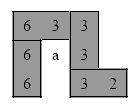
East seizes the scoring opportunity left by West by playing the [5:3] in the "a" slot. Two of the adjacent "three" segments match segments already on the tableau (tinted green in the next diagram), so E-W scores one point. South doesn’t see any immediate way to score, so he assumes that North was asking for support with the two. But South is weak in twos, only having the double, and since it’s right there in his hand, North obviously can’t hold it. So South does the only thing he can think of, building "something" out toward the two left by North without leaving obvious scoring opportunities for the now leading E-W team. Since the [6:6] was already played, South figures that the [6:0] is a safe play, and may even help. West has few choices for moves, but hopes to set up East for another score by building off the two end of North’s last play with the [5:2]. South’s [6:0] play was, indeed, fortuitous for North, who can now score a point with his [2:0] by matching two segments already on the tableau (shaded blue below). At the end of the second round, the score is tied at one to one, and the hands and tableau are as follows:
- North - [6:5] [6:2] [4:4] [4:1] [4:0]
- East - [6:1] [5:5] [5:4] [2:1] [0:0]
- South - [5:1] [4:3] [3:1] [2:2] [1:0]
- West - [6:4] [5:0] [4:2] [3:0] [1:1]
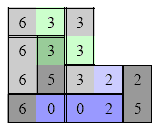
East builds his [2:1] on West’s two, making a slot accessible only to E-W that will score a point if West can place a two in the gap. Since the slot is two spaces wide, as long as either West or East still has a two, South can do nothing to prevent them scoring the point, and capping the other end could make matters worse by allowing a three-segment match for five points. Resigned to this eventuality, South hopes that whatever West plays in the slot will also give North a scoring opportunity on the other end. With that hope, South extends from the one with the [5:1]. West scores a point by dropping the [4:2] in the slot created by East. This is a lucky break for North, who evens up the score by playing the [4:1] across the end of the tiles East and West played. At the end of the third round, the score is still tied, two to two, and the hands and tableau are as follows:
- North - [6:5] [6:2] [4:4] [4:0]
- East - [6:1] [5:5] [5:4] [0:0]
- South - [4:3] [3:1] [2:2] [1:0]
- West - [6:4] [5:0] [3:0] [1:1]
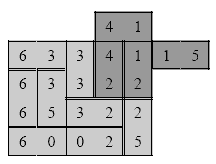
Helped by South’s extension, North left East with an easy scoring opportunity with the adjacent ones. East plays [6:1] and scores one point. South scores another quick point with the [4:3]. West makes another slot with the [5:0], hoping to set up East for a score with the [2:2] or [1:0], the [5:1], [2:1] and [2:0] all having already been played. Fixated on the slot, North overlooks the opportunity to score with the [4:4]. North can’t block a deep slot, so he creates a shallow one instead by playing [6:5], hoping that East will go ahead with the score, and maybe South will have a four coupled with either a five or six, the [4:1] having already been played. At the end of the fourth round, the score is still tied, now at three to three, and the hands and tableau appear as follows:
- North - [6:2] [4:4] [4:0]
- East - [5:5] [5:4] [0:0]
- South - [3:1] [2:2] [1:0]
- West - [6:4] [3:0] [1:1]
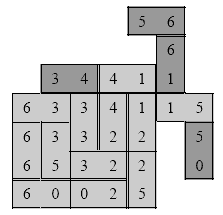
With over half of the tiles played, East no longer has either tile that will score in the slot created by West, but due to its orientation, East doesn’t have to worry about the N-S team playing there. Fortunately, North’s blunder left a scoring opportunity that also cuts off the slot. East makes a bold play with the [5:4], and knowing that the last five, [5:5] remains in his hand, saves it to score on the next turn. South could not have scored in North’s shallow slot anyway, and with most of the twos surrounded, is desperate not to get stuck with the [2:2]. South makes a vulnerable play of the [2:2], hoping that North, rather than West, has the last two. As luck would have it, West does not have the [6:2], but he knows it’s still out there, and doesn’t want North to score with it if he has it. So West makes a strong move by blocking with the [6:4]. Stunned, the only thing North sees is try to set himself up for a score with the [4:4] on his next turn by playing the [4:0]. This, too, is not the best play - North could have scored this turn instead of next by playing either the [4:0] or the [4:4] into the corner created by West’s [5:4] play. At the end of the fifth round, E-W leads with a score of four to three, and the hands and tableau appear as follows:
- North - [6:2] [4:4]
- East - [5:5] [0:0]
- South - [3:1] [1:0]
- West - [3:0] [1:1]
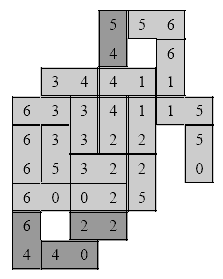
As planned, East scores another point with the [5:5]. South, exasperated by North’s errors, and seeing no good scoring opportunities, plays the [1:0] in a poor location. West, knowing the [0:0] is still out, plays the [3:0] in such a way that only East may score with it. North ends the round by finally playing the [4:4], scoring a much needed point. At the end of the sixth round, E-W leads in points, five to four, and the hands and tableau appear as follows:
- North - [6:2]
- East - [0:0]
- South - [3:1]
- West - [1:1]
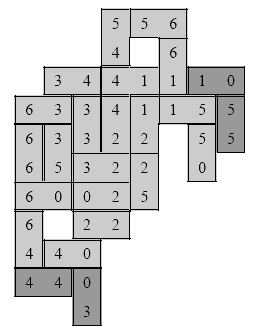
East scores with the [0:0]. South knows that the [1:1] is still out there, but can’t completely shut E-W out of ones for the penalty point, so he lays off the [3:1]. West plays the [1:1] in the deep slot, and North lays off the [6:2]. At the end of the hand, E-W leads six points to four, and the tableau appears as follows:
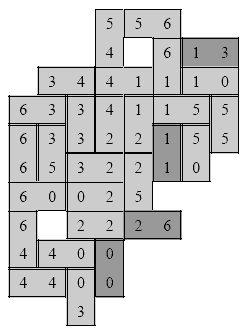
A two point deficit is not too bad, but the N-S team will have to play aggressively in the upcoming hands if they want to make up the lost ground. In particular, North had better pay more attention to the game.
This is Broadway version 1.1.4, copyright © Clark D. Rodeffer , August 30, 2006. The name Broadway was suggested by Jonathan Norris and Ruth Sanderson, and won a poll conducted to name this game in late 2006 and early 2007.